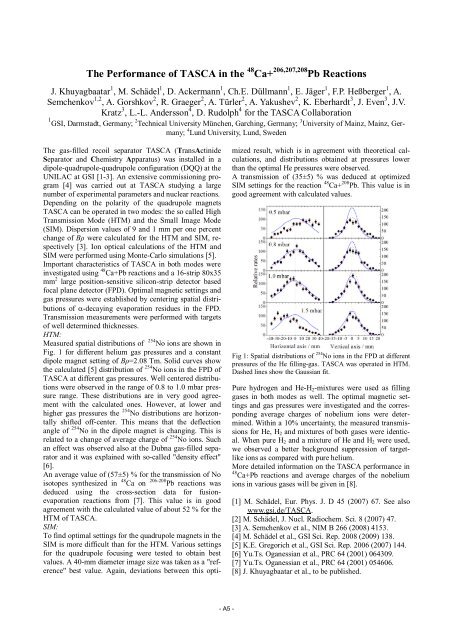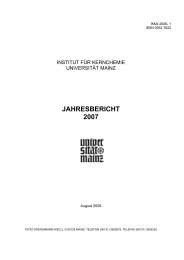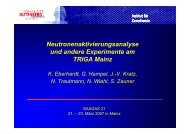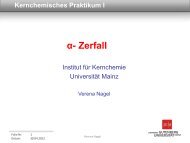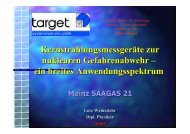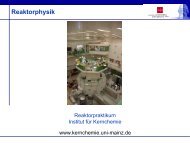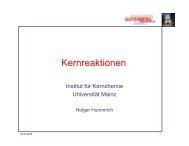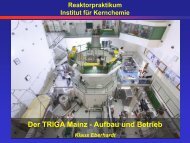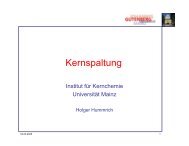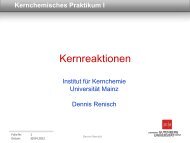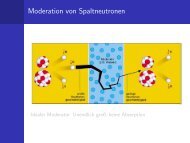institut für kernchemie universität mainz jahresbericht 2009
institut für kernchemie universität mainz jahresbericht 2009
institut für kernchemie universität mainz jahresbericht 2009
You also want an ePaper? Increase the reach of your titles
YUMPU automatically turns print PDFs into web optimized ePapers that Google loves.
GSITemp late2007<br />
The Performance of TASCA in the 48 Ca+ 206,207,208 Pb Reactions<br />
J. Khuyagbaatar 1 , M. Schädel 1 , D. Ackermann 1 , Ch.E. Düllmann 1 , E. Jäger 1 , F.P. Heßberger 1 , A.<br />
Semchenkov 1,2 , A. Gorshkov 2 , R. Graeger 2 , A. Türler 2 , A. Yakushev 2 , K. Eberhardt 3 , J. Even 3 , J.V.<br />
Kratz 3 , L.-L. Andersson 4 , D. Rudolph 4 for the TASCA Collaboration<br />
1 GSI, Darmstadt, Germany; 2 Technical University München, Garching, Germany; 3 University of Mainz, Mainz, Germany;<br />
4 Lund University, Lund, Sweden<br />
The gas-filled recoil separator TASCA (TransActinide<br />
Separator and Chemistry Apparatus) was installed in a<br />
dipole-quadrupole-quadrupole configuration (DQQ) at the<br />
UNILAC at GSI [1-3]. An extensive commissioning program<br />
[4] was carried out at TASCA studying a large<br />
number of experimental parameters and nuclear reactions.<br />
Depending on the polarity of the quadrupole magnets<br />
TASCA can be operated in two modes: the so called High<br />
Transmission Mode (HTM) and the Small Image Mode<br />
(SIM). Dispersion values of 9 and 1 mm per one percent<br />
change of �� were calculated for the HTM and SIM, respectively<br />
[3]. Ion optical calculations of the HTM and<br />
SIM were performed using Monte-Carlo simulations [5].<br />
Important characteristics of TASCA in both modes were<br />
investigated using 48 Ca+Pb reactions and a 16-strip 80x35<br />
mm 2 large position-sensitive silicon-strip detector based<br />
focal plane detector (FPD). Optimal magnetic settings and<br />
gas pressures were established by centering spatial distributions<br />
of �-decaying evaporation residues in the FPD.<br />
Transmission measurements were performed with targets<br />
of well determined thicknesses.<br />
HTM:<br />
Measured spatial distributions of 254 No ions are shown in<br />
Fig. 1 for different helium gas pressures and a constant<br />
dipole magnet setting of ��=2.08 Tm. Solid curves show<br />
the calculated [5] distribution of 254 No ions in the FPD of<br />
TASCA at different gas pressures. Well centered distributions<br />
were observed in the range of 0.8 to 1.0 mbar pressure<br />
range. These distributions are in very good agreement<br />
with the calculated ones. However, at lower and<br />
higher gas pressures the 254 No distributions are horizontally<br />
shifted off-center. This means that the deflection<br />
angle of 254 No in the dipole magnet is changing. This is<br />
related to a change of average charge of 254 No ions. Such<br />
an effect was observed also at the Dubna gas-filled separator<br />
and it was explained with so-called "density effect"<br />
[6].<br />
An average value of (57±5) % for the transmission of No<br />
isotopes synthesized in 48 Ca on 206-208 Pb reactions was<br />
deduced using the cross-section data for fusionevaporation<br />
reactions from [7]. This value is in good<br />
agreement with the calculated value of about 52 % for the<br />
HTM of TASCA.<br />
SIM:<br />
To find optimal settings for the quadrupole magnets in the<br />
SIM is more difficult than for the HTM. Various settings<br />
for the quadrupole focusing were tested to obtain best<br />
values. A 40-mm diameter image size was taken as a "reference"<br />
best value. Again, deviations between this opti-<br />
mized result, which is in agreement with theoretical calculations,<br />
and distributions obtained at pressures lower<br />
than the optimal He pressures were observed.<br />
A transmission of (35±5) % was deduced at optimized<br />
SIM settings for the reaction 48 Ca+ 208 Pb. This value is in<br />
good agreement with calculated values.<br />
Fig 1: Spatial distributions of 254 No ions in the FPD at different<br />
pressures of the He filling-gas. TASCA was operated in HTM.<br />
Dashed lines show the Gaussian fit.<br />
Pure hydrogen and He-H2-mixtures were used as filling<br />
gases in both modes as well. The optimal magnetic settings<br />
and gas pressures were investigated and the corresponding<br />
average charges of nobelium ions were determined.<br />
Within a 10% uncertainty, the measured transmissions<br />
for He, H2 and mixtures of both gases were identical.<br />
When pure H2 and a mixture of He and H2 were used,<br />
we observed a better background suppression of targetlike<br />
ions as compared with pure helium.<br />
More detailed information on the TASCA performance in<br />
48 Ca+Pb reactions and average charges of the nobelium<br />
ions in various gases will be given in [8].<br />
[1] M. Schädel, Eur. Phys. J. D 45 (2007) 67. See also<br />
www.gsi.de/TASCA.<br />
[2] M. Schädel, J. Nucl. Radiochem. Sci. 8 (2007) 47.<br />
[3] A. Semchenkov et al., NIM B 266 (2008) 4153.<br />
[4] M. Schädel et al., GSI Sci. Rep. 2008 (<strong>2009</strong>) 138.<br />
[5] K.E. Gregorich et al., GSI Sci. Rep. 2006 (2007) 144.<br />
[6] Yu.Ts. Oganessian et al., PRC 64 (2001) 064309.<br />
[7] Yu.Ts. Oganessian et al., PRC 64 (2001) 054606.<br />
[8] J. Khuyagbaatar et al., to be published.


